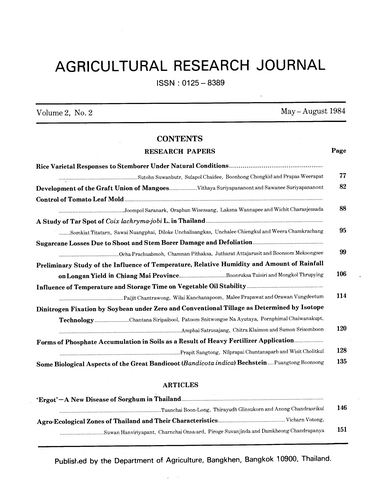Ergot'-A New Disease of Sorghum in Thailand
Abstract
The disease 'ergot' was identified in Thailand in a crop of sudax (developed from crosses between selected sorghum and sudan grasses) in teh growing season of 1983. seed of sudax had been introduced to Thailand in 1982 for use in pasture and hay production and was intially planted in the provinces of Nakhon Ratchasima and Ratchaburi. Symptoms of the disease included seed rot associated with a sticky honey-dew mass on the ovary of young florets. The conidia were hyaline, aseptate, oblong to oval shaped, averaged 13.90 x 7.72 u in size, and had a vacuold-like body at each end. The fungus was identified as Sphacelia sorghi, the imperfect stage of Clavicep sp. Cross inoculation to sorghum at the milky stage of development using a conidia suspension was successful; however, the perfect stage was not found in 1983.
In 1984 the disease spread to male sterile sorghum lines being used to develope hybrids in Saraburi province. All male sterile A-lines became quickly infected with the infection developing rapidly.
Toxigencity of the organism was studied under laboratory condition. The study revealed that the pathogen was capable of producing toxic products. The procedure used to test toxigenicity was (i) production of crude toxin on sterile glutinous rice after inoculation by a clavicep spore suspension at 25 - 30 C for 10 days, (ii) extraction with chloroform, (iii) preciptitation of crude toxin in cold petroleum ether, and (iv) toxicity of the crude toxin to mice. Crude toxin obtained from both moldy sorghum and glutinous rice was toxic to mice when given intra peritoneal injection adn intra gastric Symptoms included death within 1 - 3 days and a range of histopathological changes. The precise nature of the toxic substances produced has yet to be established.
Downloads
Published
How to Cite
Issue
Section
License
Thai Agricultural Research Journal



